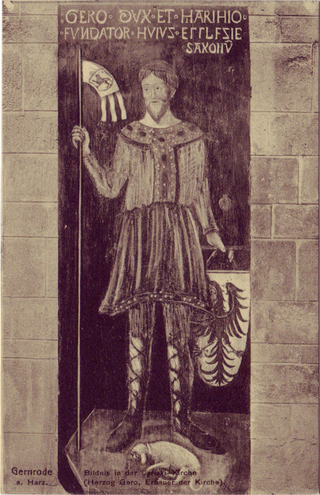Gero (died 21 October 1023) was the Archbishop of Magdeburg from 1012 until his death. He was a son of Dedo Wodenswege and Eilika (Eilica) and possibly a relative of the family of Gero the Great.
Gero was the candidate of King Henry II following the death of the Archbishop Walthard on 12 August 1012. He was appointed over the candidate, Otto, of the cathedral canons. [1] Between 1016 and 1017, the ambitious Gero and Bernard, Margrave of the Nordmark, feuded over territory. [2] Bernard's men attacked Magdeburg, but in 1017 he agreed to compensate Gero with 500 pounds of silver. [3]

Otto III was Holy Roman Emperor from 996 until his death in 1002. A member of the Ottonian dynasty, Otto III was the only son of the Emperor Otto II and his wife Theophanu.

The Archbishopric of Magdeburg was a Latin Catholic archdiocese (969–1552) and Prince-Archbishopric (1180–1680) of the Holy Roman Empire centered on the city of Magdeburg on the Elbe River.

The Peace of Bautzen was a treaty concluded on 30 January 1018, between Holy Roman Emperor Henry II and Bolesław I of Poland which ended a series of Polish-German wars over the control of Lusatia and Upper Lusatia as well as Bohemia, Moravia and Slovakia.

Gero I, sometimes called the Great, was a German nobleman who ruled an initially modest march centred on Merseburg in the south of the present German state of Saxony-Anhalt, which he expanded into a vast territory named after him: the marca Geronis. During the mid-10th century, he was the leader of the Saxon Ostsiedlung.

Thietmar, Prince-Bishop of Merseburg from 1009 until his death in 1018, was an important chronicler recording the reigns of German kings and Holy Roman Emperors of the Ottonian (Saxon) dynasty. Two of Thietmar's great-grandfathers, both referred to as Liuthar, were the Saxon nobles Lothar II, Count of Stade, and Lothar I, Count of Walbeck. They were both killed fighting the Slavs at the Battle of Lenzen.

Hermann Billung was the margrave of the Billung March from 936 until his death. The first of the Saxon House of Billung, Hermann was a trusted lieutenant of Emperor Otto I.
Tagino was the third Archbishop of Magdeburg from 1004 until his death.
Henry of Schweinfurt was the Margrave of the Nordgau from 994 until 1004. He was called the "glory of eastern Franconia" by his own cousin, the chronicler Thietmar of Merseburg.

The Marca Geronis was a vast super-march in the middle of the tenth century. It was created probably for Thietmar and passed to his two sons consecutively: Siegfried and Gero. On Gero's death in 965 it was divided into five different marches: the Nordmark, the Ostmark, Meissen, Zeitz, and Merseburg.

Eckard I was Margrave of Meissen from 985 until his death. He was the first margrave of the Ekkehardinger family that ruled over Meissen until the extinction of the line in 1046.
Dietrichof Haldensleben was a count in the Schwabengau, later also in the Nordthüringgau and the Derlingau, who was the first Margrave of the Northern March from 965 until the Great Slav Rising of 983. He also bore the title of a dux (duke) in contemporary sources.
Walthard was the Archbishop of Magdeburg very briefly from June to August in 1012.

OdoI was margrave in the Saxon Eastern March of the Holy Roman Empire from 965 until his death.
BernardII of Haldensleben was the Margrave of the Nordmark from 1018 until his death. He was the grandson of Dietrich of Haldensleben and a rival of the counts of Walbeck, one of whom, Werner, succeeded him in the march following his deposition.
Wichmann von Seeburg was Bishop of Naumburg from 1150 until 1154 and Archbishop of Magdeburg from 1154 until his death. He became the first Magdeburg prince-archbishop in 1180

Otto I, traditionally known as Otto the Great, or Otto of Saxony was East Frankish king from 936 and Holy Roman Emperor from 962 until his death in 973. He was the eldest son of Henry the Fowler and Matilda of Ringelheim.

Henry II, also known as Saint Henry the Exuberant, Obl. S. B., was Holy Roman Emperor from 1014. He died without an heir in 1024, and was the last ruler of the Ottonian line. As Duke of Bavaria, appointed in 995, Henry became King of the Romans following the sudden death of his second cousin, Emperor Otto III in 1002, was made King of Italy in 1004, and crowned emperor by Pope Benedict VIII in 1014.

The German–Polish War consisted of a series of struggles in 1003–1018, between the Ottonian king Henry II of Germany and the Polish Piast ruler Bolesław I the Brave. The locus of conflict was the control of Lusatia, Upper Lusatia, as well as Bohemia, Moravia and Slovakia. The fighting ended with the Peace of Bautzen in 1018, which left Lusatia and Upper Lusatia as a fief of Poland, and Bohemia became a duchy in the Holy Roman Empire.
Christian was count in the Saxon Nordthüringgau and Schwabengau from 937. He also ruled in the neighbouring Gau Serimunt of the Marca Geronis from 945.
Frederick I, Count of Eilenburg was a son of Count Dietrich I and the brother of Dedo I of Wettin. His birthday is unknown.